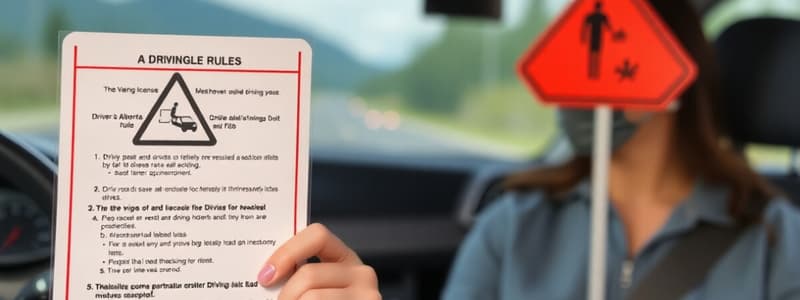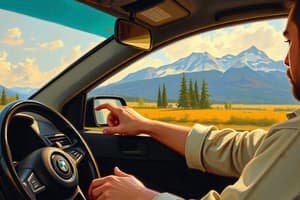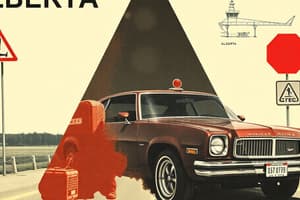Podcast
Questions and Answers
Unless otherwise posted, what is the basic speed limit outside a city, town or village on a primary highway?
Unless otherwise posted, what is the basic speed limit outside a city, town or village on a primary highway?
- 110 km/h
- 90 km/h
- 100 km/h (correct)
- 80 km/h
When backing a passenger vehicle to the left, a driver should:
When backing a passenger vehicle to the left, a driver should:
- Look over the left shoulder with occasional glances to the front (correct)
- Look over the right shoulder with occasional glances to the front
- Look in the inside rear-view mirror and make steering adjustments as necessary
- Without shoulder checking, use the inside and outside rear-view mirrors to ensure the best view to the rear and both sides of the vehicle
When approaching an intersection and facing a traffic control light that is showing a green right-turn arrow and a red light, a driver:
When approaching an intersection and facing a traffic control light that is showing a green right-turn arrow and a red light, a driver:
- May proceed when safe, without stopping, in the direction of the arrow (correct)
- May turn left without stopping
- Must stop and wait for a green light before turning in the direction of the arrow
- May go straight through the intersection without stopping
Alberta has a demerit point system where a fully licenced (non-learner, non-probationary) driver is suspended when they accumulate:
Alberta has a demerit point system where a fully licenced (non-learner, non-probationary) driver is suspended when they accumulate:
When passing a large truck on a two-way highway, a driver should:
When passing a large truck on a two-way highway, a driver should:
Which statement best describes the steps for turning right at a red traffic light?
Which statement best describes the steps for turning right at a red traffic light?
This sign indicates:
This sign indicates:
A single solid white line between driving lanes in an urban area means:
A single solid white line between driving lanes in an urban area means:
A "parking lane" as defined in the Basic Licence Driver's Handbook is:
A "parking lane" as defined in the Basic Licence Driver's Handbook is:
Shoulder checking means:
Shoulder checking means:
This sign indicates:
This sign indicates:
A traffic-lane control light with an illuminated red "X" means:
A traffic-lane control light with an illuminated red "X" means:
Does a parent have the right to withdraw a previously given "parental consent" for someone under 18 years of age with respect to an operator's licence?
Does a parent have the right to withdraw a previously given "parental consent" for someone under 18 years of age with respect to an operator's licence?
When approaching a Yield sign, you must:
When approaching a Yield sign, you must:
The term "over-driving" your headlights at night means:
The term "over-driving" your headlights at night means:
Under the Graduated Driver Licensing program, a driver will receive 2 demerits:
Under the Graduated Driver Licensing program, a driver will receive 2 demerits:
Using the 2-second rule to judge a safe following distance when driving:
Using the 2-second rule to judge a safe following distance when driving:
This sign indicates:
This sign indicates:
A driver approaching a flashing red traffic light must:
A driver approaching a flashing red traffic light must:
This sign indicates:
This sign indicates:
According to the law in Alberta, it is the driver's responsibility to ensure that all passengers under what age are properly restrained in the vehicle?
According to the law in Alberta, it is the driver's responsibility to ensure that all passengers under what age are properly restrained in the vehicle?
When parallel parking, the vehicle's wheels closest to the curb must be within what maximum distance?
When parallel parking, the vehicle's wheels closest to the curb must be within what maximum distance?
Who is responsible and legally obligated to report any medical condition, change in health, or physical disability that may affect a driver's ability to drive?
Who is responsible and legally obligated to report any medical condition, change in health, or physical disability that may affect a driver's ability to drive?
This sign indicates:
This sign indicates:
This sign indicates:
This sign indicates:
Under the Graduated Driver Licensing program, what is the minimum amount of time that a person must serve as a probationary Class 5 driver?
Under the Graduated Driver Licensing program, what is the minimum amount of time that a person must serve as a probationary Class 5 driver?
A large "X" painted on the pavement indicates:
A large "X" painted on the pavement indicates:
A driver is required to report all collisions to the police when persons have been injured or killed, or when combined damage to all vehicles or property is more than:
A driver is required to report all collisions to the police when persons have been injured or killed, or when combined damage to all vehicles or property is more than:
When a driver is stopping behind another vehicle in traffic:
When a driver is stopping behind another vehicle in traffic:
If another vehicle is following too close, what should a driver do?
If another vehicle is following too close, what should a driver do?
When recovering from a skid, a driver should:
When recovering from a skid, a driver should:
A "slow-moving vehicle" sign must be displayed on the rear of any vehicle that normally travels at speeds less than:
A "slow-moving vehicle" sign must be displayed on the rear of any vehicle that normally travels at speeds less than:
A driver attempting to turn left at a steady green traffic light:
A driver attempting to turn left at a steady green traffic light:
A "Weave Zone" is best described as:
A "Weave Zone" is best described as:
A road test will be refused by a driver examiner if:
A road test will be refused by a driver examiner if:
Is a driver allowed to exceed the speed limit when passing another vehicle?
Is a driver allowed to exceed the speed limit when passing another vehicle?
This sign indicates:
This sign indicates:
The speed limit in a construction zone must be obeyed:
The speed limit in a construction zone must be obeyed:
In a vehicle that does not have anti-lock brakes, threshold braking refers to:
In a vehicle that does not have anti-lock brakes, threshold braking refers to:
When a driver's vehicle is approached by an emergency vehicle sounding a siren, from any direction on a two-way road, the driver must:
When a driver's vehicle is approached by an emergency vehicle sounding a siren, from any direction on a two-way road, the driver must:
The recommended braking procedure to bring a vehicle to a normal, smooth stop is:
The recommended braking procedure to bring a vehicle to a normal, smooth stop is:
In Alberta, the law requires that seat belts must be worn:
In Alberta, the law requires that seat belts must be worn:
This sign indicates:
This sign indicates:
A driver entering a traffic circle:
A driver entering a traffic circle:
A deceleration lane is:
A deceleration lane is:
When turning left from a two-way road onto a one-way road, what lane should the vehicle enter?
When turning left from a two-way road onto a one-way road, what lane should the vehicle enter?
When two vehicles approach an uncontrolled "T" intersection at right angles to each other at approximately the same time:
When two vehicles approach an uncontrolled "T" intersection at right angles to each other at approximately the same time:
Unless otherwise permitted, what lane must a driver be in to turn left from a one-way road?
Unless otherwise permitted, what lane must a driver be in to turn left from a one-way road?
Which statement describes the steps required to reverse in a straight line?
Which statement describes the steps required to reverse in a straight line?
An acceleration lane is:
An acceleration lane is:
Flashcards
Basic speed limit (primary highway)
Basic speed limit (primary highway)
Outside cities, towns, and villages on primary highways, the speed limit is 100 km/h unless otherwise posted.
Backing a passenger vehicle (left)
Backing a passenger vehicle (left)
To back up safely, look over your right shoulder, and check side view mirrors occasionally.
Green right-turn arrow & red light
Green right-turn arrow & red light
Proceed safely in the direction of the arrow, without stopping.
Alberta driver demerit points suspension
Alberta driver demerit points suspension
Signup and view all the flashcards
Passing a large truck
Passing a large truck
Signup and view all the flashcards
Turning right at a red light
Turning right at a red light
Signup and view all the flashcards
Sign indicating route for vehicles over 4500kg
Sign indicating route for vehicles over 4500kg
Signup and view all the flashcards
Single solid white line (urban)
Single solid white line (urban)
Signup and view all the flashcards
Parking lane
Parking lane
Signup and view all the flashcards
Shoulder checking
Shoulder checking
Signup and view all the flashcards
Traffic-lane control light (red 'X')
Traffic-lane control light (red 'X')
Signup and view all the flashcards
Withdrawal parental consent on license
Withdrawal parental consent on license
Signup and view all the flashcards
Yield sign action
Yield sign action
Signup and view all the flashcards
Over-driving headlights
Over-driving headlights
Signup and view all the flashcards
Study Notes
Alberta Basic Licence Drivers Assessment
-
Speed Limit: The basic speed limit outside a city, town or village on a primary highway is 90 km/h, unless otherwise posted.
-
Backing a Vehicle: When backing a passenger vehicle to the left, look over the left shoulder, with occasional glances to the front, and use the inside and outside rear-view mirrors to ensure a clear view of the rear and both sides of the vehicle.
-
Green Right-Turn Arrow: When approaching an intersection with a green right-turn arrow and a red light, a driver may proceed, when safe, without stopping, in the direction of the arrow.
-
Demerit Points: Accumulating 15 demerit points for a fully licensed driver (non learner, non probationary) will result in the suspension of their driving privileges.
-
Passing a Large Truck: When passing a large truck on a two-way highway, leave extra room before returning to your lane. Return to your lane when the truck is no longer visible in any rear-view mirrors, and once you have cleared the truck's front bumper.
-
Turns at a Red Light: Right turns at a red traffic light are permitted, provided the driver signals and ensures there are no signs prohibiting the turn, stops, and looks left and right, yields the right-of-way, and then proceeds.
-
White Line: A single solid white line between driving lanes in an urban area means lane changing is not permitted.
-
Parking Lane: A parking lane is defined as that part of the highway between the edge of the roadway to the right of the direction of traffic and the nearest solid white line (not the centre line).
-
Shoulder Checking: Shoulder checking means glancing towards the blind spot in the direction the driver intends to move.. This includes glancing into the right outside mirror.
-
Off-Road Facilities Sign: This sign indicates off-road facilities ahead.
-
Red "X" Traffic-Lane Control Light: A red "X" traffic-lane control light means travel is not permitted in that lane.
-
Parental Consent for Driving License: A parent has the right to withdraw a previously given "parental consent" for someone under 18 years of age with respect to an operator's license, provided the person is still under 18 and not self-supporting or married.
-
Yield Sign: When approaching a yield sign, yield the right-of-way to traffic not facing the sign and all pedestrians in the intersection, come to a stop and proceed when safe.
-
Over-Driving Headlights: "Over-driving" your headlights at night means you are driving too fast, preventing you from seeing an object in time to stop, rather than simply having your headlights on for too long.
-
Demerit Points for Seatbelts Drivers will receive 2 demerits under the Graduated Driver Licensing program for not wearing a seat belt securely fastened.
-
Threshold Braking In vehicles without anti-lock brakes, threshold braking involves applying even pressure to the brake pedal until the vehicle's wheels are about to lock.
-
Emergency Vehicles If a driver's vehicle is approached by an emergency vehicle, they must drive to the right curb, stop, and allow the emergency vehicle to pass.
-
Braking Procedure: The recommended braking procedure is to apply steady pressure to the brake pedal, ease off slightly just before stopping the vehicle, and re-apply sufficient pressure to stop.
-
Seatbelt Regulations: In Alberta, the law requires all passengers to wear seatbelts at all times.
-
Traffic Circle Etiquette: When entering a traffic circle, yield to traffic already in the traffic circle and use the courtesy rule, yielding to the vehicle that arrived first or earlier.
-
Deceleration Lane: A deceleration lane is a lane on a highway where vehicles reduce speed when exiting a highway, specifically the right lane of a four-lane highway used by slower vehicles.
-
T-Intersection: When two vehicles approach an uncontrolled "T" intersection at right angles, the vehicle on the left must yield to the vehicle on the right.
-
One-Way Road Turn: To turn left out of a one-way road, the driver must be in the left lane.
-
Reverse Procedure: To reverse in a straight line, keep both hands on the steering wheel and constantly use the inside rear-view mirror for guidance. Place the right hand at the top of the steering wheel, look over the left, and use the outside left rear-view mirror.
-
School Zone Speed: In a school zone, the posted speed limit applies at all times, regardless of whether the driver is visible or not visible.
-
Acceleration Lane: An acceleration lane is a lane designated for faster moving vehicles on highways and roads.
-
Parallel Parking: When parallel parking uphill on a two-way road, the vehicle's front wheels should be turned to the left.
-
School Bus Stopping: A driver approaching the rear of a stopped school bus displaying alternating flashing red lights must stop their vehicle until the lights stop flashing.
-
Nighttime Driving: Nighttime is defined as the period beginning 1 hour before sunset and ending 1 hour after sunrise.
-
Intersections (and Traffic Control Signals): Follow applicable traffic signs and lights carefully at all intersections.
-
Pedestrian Crosswalks: Stop before the pedestrian crosswalk line when approaching a pedestrian crosswalk.
-
Parking near Stop Signs: Do not park within 10 meters of a stop sign.
-
Fire Hydrant Parking: Do not park within 2 meters of a fire hydrant.
-
Additional Signs and Signals: Be aware of other additional traffic signs and signals that may pertain to your driving conditions and/or route.
Studying That Suits You
Use AI to generate personalized quizzes and flashcards to suit your learning preferences.




